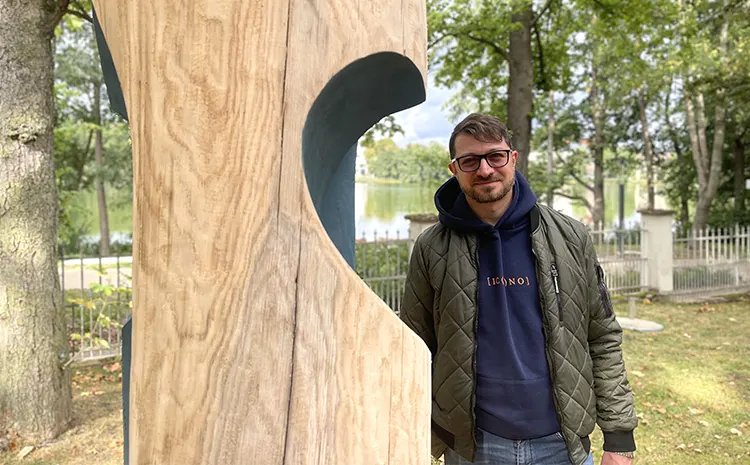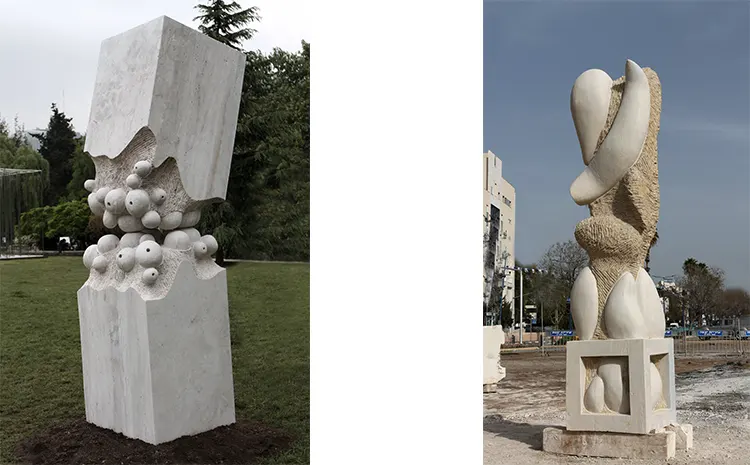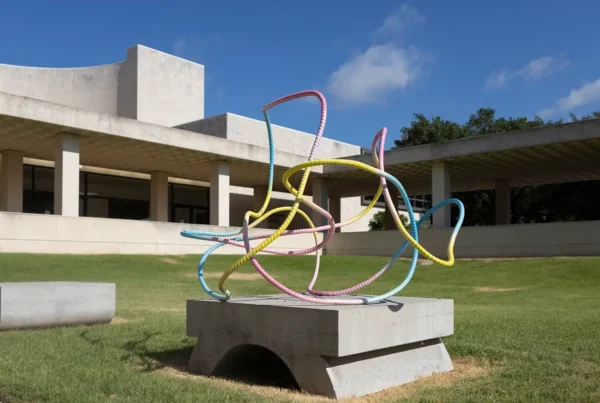“I am not thinking about art when I am doing it, I just live with it and its passion, and I hope that it will change someone else’s visions too.”
The Birth of Raffò’s Sculptural Language
The dynamic and ever-evolving world of sculpture is exemplified by the work of Rafail Lubomirov Georgiev, known professionally as Raffò. Born in Razgrad, Bulgaria in 1986, the artist was raised in a creative household, with a sculptor father and a drama actress mother. Raffò’s early years were spent immersed in the arts, splitting his time between his father’s studio and the theater where his mother performed. This early exposure to art and aesthetics fostered a profound appreciation for nature’s beauty, which Raffò experienced in Bulgaria’s Ludogorie region. In 1999, his family relocated to Sofia, the country’s capital, where Raffò would embark on an extensive and international education in sculpture, leading to a diverse array of public and private projects. This article examines Raffò’s education, teaching career, awards, public sculptures, private collections, symposiums, and exhibitions, showcasing an impressive oeuvre that has earned global acclaim and continues to captivate and challenge audiences worldwide.
Raffò obtained his Bachelor of Arts degree in Sculpture from the National Fine Art Academy in Sofia, Bulgaria in 2010, under the tutelage of renowned Bulgarian sculptor, Academic Prof. Krum Damyanov. He continued his studies in Rome, Italy, completing his Master of Arts degree in Environmental Sculpture and Lapis Tiburtinus at the Academy of Fine Art in 2014, where he resided and studied for four years. Over the course of eight years of academic study between Bulgaria and Italy, Raffò began developing his unique sculptural language during the final two years in Rome. Through exploration of various fields, including figurative, abstract, and conceptual art, he discerned the direction that best suited his artistic vision and imagination.
In the years following his academic studies, Raffò’s artistic language evolved, taking on diverse forms and shapes, and giving rise to new narratives and concepts. The artist acknowledges that his artistic upbringing, academic education, and exposure to different cultures and locations have greatly influenced his approach to sculpture and art in general. Occasionally, Raffò revisits drawings, sketches, and ideas from over a decade ago, discovering that some of these initial concepts may still hold relevance and potential for his current work. This practice highlights the importance of archiving and preserving even those sketches that may have once seemed “useless,” as they can provide inspiration and insight for an artist’s ongoing creative journey.

The Intersection of Humans and Nature in Raffò’s Sculptures
Raffò recognized his true identity as an artist during his first year as a student in Rome, Italy. Immersed in the historical heart of the city, he seized the opportunity to create his first large-scale stone sculpture and install it in the natural park of Palombara Sabina, a province of Rome. This initial achievement fueled his belief in the power of interacting with the outdoor space, extending his ideas beyond the boundaries of the sculpture itself.
When creating a new sculpture, object, drawing, or painting, Raffò does not consciously consider whether he is producing art. Instead, he focuses on the various elements of the creative process, allowing them to become an integral part of his life. Although common sense might affirm that his creations are indeed art, the artist remains critical of such hasty conclusions, recognizing that not everyone who employs the language of art is genuinely creating it. Raffò’s approach to art is more organic; he lives with it and its passion, hoping that his work might inspire shifts in others’ perspectives as well.
The styles, methods, and ideas in Raffò’s sculptures vary, but a consistent theme is the dialogue between humans as Logos (rationality) and nature as Chaos (irrationality). He finds common ground in his works at the intersection of these two principles. Raffò also believes that some of his pieces may be interpreted as representations of archetypes relating to aspects of nature, human nature, or culture.
This conclusion stems from both the feedback he receives from visitors, colleagues, friends, and family, as well as his personal beliefs and aspirations. Casual remarks suggesting resemblances or symbolic representations contribute to Raffò’s confidence in his artistic path, as he strives to convey ideas through shapes and forms that do not explicitly illustrate specific objects. Simultaneously, he seeks to create sculptural forms with visual characteristics that resonate universally across different parts of the world where he has installed public sculptures. Ultimately, Raffò aims to find a collective understanding in a form that offers a unique and singular solution.

Raffò’s Creative Process and Technical Creativity
Rafail Georgiev does not adhere to a singular type or method within his creative process. His utilization of 3D modeling and sculpting software has led to an increase in the number of sketches and ideas he generates. This is due to the enhanced speed and ease that technology offers artists in visualizing their concepts. When exploring new lines, forms, or words, Georgiev consistently begins by sketching on white paper with a pencil or pen. If satisfied with the initial sketch, he investigates further possibilities on new sheets of paper before deciding on the appropriate medium to render the idea in 3D, either through physical or digital materials.
The timeline from conception to completion for Raffò’s artwork varies greatly, spanning from mere minutes to several years. This is particularly true for outdoor public sculptures, his primary focus over the past 12 years. Such projects often require a more extended process involving multiple components and potential delays. In some cases, a sculpture initially designed for a specific location may ultimately find its place in a different environment where it harmonizes more effectively with the surroundings. Many public sculptures are integral to broader architectural projects, and as such, their realization may be stalled due to issues with preceding work necessary to establish the intended environment.
Raffò’s work on the “Formations” series (Canada, 2018; China, 2022) exemplifies the diverse technical creativity employed in his art. In the 2018 installation in Saint John, New Brunswick, Canada, he selected two large granite blocks and sketched a composition integrating them. The subsequent sculpting process was a traditional stone masonry technique, which he particularly enjoys when working with hard materials like granite. Years later, a version of “Formation” was chosen for inclusion in the prestigious Wuhu Sculpture Park in China. In this instance, Georgiev created the initial prototype using 3D software, and the monument was enlarged and constructed using a 6-axis 3D CNC robot under his supervision in a sculpture factory in Beijing.
While Georgiev’s projects predominantly involve natural stone, bronze, wood, and stainless steel, he remains open to experimentation with unconventional materials. His creative process can be described as a blend of the Latin concepts “Homo Faber” (a man who makes) and “Homo Ludens” (a man who plays), reflecting the importance of both craftsmanship and imagination.
Raffò’s ideal working environment is one that is close to nature. In the absence of loud machinery, he finds solace in the sounds of birds, wind, and silence. Although his current studios are situated in urban areas, he aspires to establish a workspace in a more rural setting to explore potential shifts in his artistic thought process. However, he recognizes that an ideal working environment may be a utopian concept, as a continually evolving artist requires an equally dynamic environment.

The Ongoing Evolution of Raffò’s Sculptural Themes and Concepts
Raffò believes that the creation of each new sculpture or artwork is a process of conveying emotions ranging from pain to pleasure, but never settling in between. He asserts that if his emotions remain balanced throughout the creative process, it implies a routine, suggesting less novelty and a predictable outcome. This, in turn, leans more towards craft than art. Raffò acknowledges that not every idea can yield results that can be classified as art, and sometimes artists may find themselves trapped in a cycle, requiring external inspiration to break free.
With over a decade of experience in public sculpture across 14 countries, including Italy, Germany, Canada, Bulgaria, Israel, France, China, Romania, Chile, Turkey, Costa Rica, South Korea, Taiwan, and Denmark, Raffò can now perceive a bigger picture. He recognizes that commercial success does not always bring artistic satisfaction and vice versa. The artist takes pride in having realized several main concepts in a series of works he has been developing concurrently over the years, including the Temples, Arches, and Columns series. This collection of public sculptures has been showcased around the world, featuring renowned pieces such as “Temple of the Elements,” “In the Maternal Womb,” “That Future is Hiding in a Past Harmony,” “Mental Curves,” “Four Genetic Gates,” “Floyd Column,” “Floyd Column 2,” “Floyd Arch,” and “Internal Movement.”
In 2016, Raffò initiated the “Dissolving” series, which includes sculptures like “Dissolving,” “Dissolving Out,” and “Dissolving Tensions.” The latter piece, crafted in Chile, presents a paradox between its core concept and the laws of physics. The artist suspends nearly three tons of solid stone in the air, creating a sophisticated play on the re-composition of form.
Another project, titled “Nature Always Finds Its Way,” explores the relationship between Platonic solids and marine creatures such as sea urchins and barnacles. Synthesized forms of these animals emerge from open craters within the perfect shapes of regular polyhedral solids. The first public sculpture of this series, “Organic Cube,” was created from a 14-ton single block of granite in South Korea.
The “Cubes and Volumes” series investigates the interplay between geometric cubic forms and raw volumes carved from stone. These sculptures depict the contrast between the rationality of humans, represented by sharp 90-degree angles, and the chaotic, asymmetric structure of nature. Public sculptures from this series include “I’m Free from Pandora,” “Dancing Cubes and Volumes,” “InSideOutSideIn,” and others.
The “Horns” series features sculptures such as “Kattegat Horns,” “Music Box,” “Sound the Horns,” and “Radio Killed the Video Star.” Meanwhile, the “Formations” series has been realized in both Canada and China.
In “Formations,” Raffò faced the challenge of working with unformed granite blocks. By studying the natural rock formations, he devised a solution that preserved 60% of the original shapes while transforming the rest. This approach allowed him to follow the intuitively shaped rock and progress with the project.
In the Canadian version of “Formations,” Raffò faced the challenge of working with unformed granite blocks. By studying the natural rock formations, he devised a solution that preserved 60% of the original shapes while transforming the rest. This approach allowed him to follow the intuitively shaped rock and progress with the project.
In the Chinese version of “Formations,” located in Wuhu, the project emphasizes form and consistency. It reimagines the geometry of parallel prisms found in modern and post-modern architecture, introducing organic forms to create new dimensions. The sculpture aims to captivate visitors with a visual spectacle of sharp lines, raw exterior walls, and organic volumes.
Both versions of the “Formations” series showcase Raffò’s artistic expertise and his unique ability to combine natural and geometric elements in his sculptures. He has a keen eye for combining organic forms with human-made structures, which can be seen throughout his various series of public sculptures around the world.
To young artists beginning their careers, Raffò advises hard work and perseverance in defending their ideas and artistic language. He warns of the negativity and aggression they may encounter and encourages them to remain optimistic in their creative pursuits. He stresses the importance of the time spent in academic studios, as the experiences gained there will provide the strength to continue.






